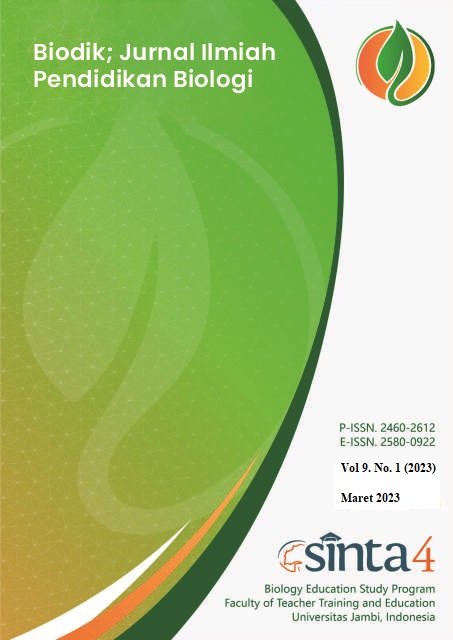Pengaruh Model Pembelajaran Problem Based Learning untuk Meningkatkan Hasil Belajar Siswa Pada Materi Sistem Reproduksi Manusia Di SMAN 10
(The Effect of Problem Based Learning Model to Increase Student Learning Outcomes on Human Reproductive System Materials in SMAN 10)
DOI:
https://doi.org/10.22437/bio.v9i1.19690Abstract
The purpose of this review is to investigate the effect of compound fish bone on the conceptual framework of school performance and medical awareness of high school students. In this review, we used a quasi-sectional study design with pre-test and post-test control package models. An example in this review is a low-level study of XI MIPA 1 and XI MIPA 2 by SMA N 10 Kota Medan, which was not fully addressed by the target test method. The information was gathered through exams and admission forms. According to the information survey, students' learning performance could be improved following the completion of the completed learning practice at the level of 79.54% and 90.48% in both classes, it was found that increased awareness of health care. Given the results, the use of the herring-problem model is very likely to affect the academic results and medical prospects of students in secondary schools.
Key words: Problem-based learning, learning outcomes, health care attitude
Â
ABSTRAK
Penelitian ini bertujuan untuk menganalisis pengaruh problem-based fishbone pada sistem reproduksi terhadap hasil belajar dan sikap pemeliharaan kesehatan siswa SMA. Penelitian ini menggunakan desain eksperimen semu dengan desain pretest-posttest control group design. Sampel penelitian ini adalah siswa kelas XI MIPA 1 dan XI MIPA 2 SMA N 10 yang ditentukan dengan teknik purposive sampling. Pengumpulan data dilakukan dengan tes dan lembar observasi. Hasil analisis data menunjukkan bahwa hasil belajar siswa dapat meningkat setelah kegiatan pembelajaran selesai dengan ketuntasan untuk kedua kelas masing-masing sebesar 79,54% dan 90,48%, dan siswa memiliki sikap peduli kesehatan yang baik. Berdasarkan hasil penelitian dapat disimpulkan bahwa penerapan model problem based-fishbone berpengaruh terhadap hasil belajar dan sikap pemeliharaan kesehatan siswa SMA.
Kata kunci: Problem Base Learning, Hasil Belajar, Sikap Perawatan Kesehatan
Downloads
References
Afcariono, M. (2008). Penerapan Pembelajaran Berbasis Masalah untuk Meningkatkan Kemampuan Berpikir Siswa pada Mata Pelajaran Biologi. Jurnal Pendidikan Inovatif. 3(2): 65–68
Baden, M. S. (2016). The Impact of Transdisciplinary Threshold Conceptson Student Engagement in Problem- Based Learning: A Conceptual Synthesis. Interdisciplinary Journal of Problem-Based Learning. 10(2) : 3-6
Bigbee, J., et al. (2010). Models in Multi-Agency C2 Experiments Lifecycles: The Collaborative Experimentation Environment as a Case Study. The International C2 Journal. 4(3): 13
Erlianti, S., Priyantini W., & Lisdiana. 2017. The Development Of Contextual Teaching and Learning Based-Video on Reproductive System Concept for SMA. Unnes Journal of Biology Education. 6(2): 169-171
Fariroh, A & Yustinus, U. A. (2015). Pengembangan Perangkat Pembelajaran Berbasis Problem Based Learning pada Materi Virus Kelas X. Unnes Journal of Biology Education .4 (2) :149-155
Fatonah, A., Lisdiana, & Supriyanto. (2017). Penerapan Biomagz sebagai Suplemen dalam Pembelajaran Sistem Reproduksi di SMA. Unnes Journal of Biology Education. 6(1): 104-109
Hadi A. M., Corebima D. A., & Saptasari M. (2010). Pengaruh Pembelajaran Problem Based Learning (PBL) terhadap Kemampuan Berpikir Kritis dan Pemahaman Konsep Biologi Siswa SMA Negeri di Kota Malang. Jurnal Penelitian Pendidikan, 11(2): 1-11.
Hamidah, I., D. R. Indriyanti, & Nugrahaningsih.W. H. (2017). Pengembangan Bahan Ajar Sub Bab Antioksidan Berbasis Kajian Pola Konsumsi Masyarakat Pesisir Indramayu. Journal of Innovative Science Education. 6 (1)
Husnidar. (2014). Penerapan Model Pembelajaran Berbasis Masalah untuk Meningkatkan Kemampuan Berpikir Kritis Siswa dan Disposisi Matematis Siswa. Jurnal Didaktik Matematika 1 (1): 71-82
Kinaseh, Niken, S. & Tyas, A, P. (2015). Pengaruh Model Problem Based Learning dengan Media Animasi Flash terhadap Hasil Belajar dan Aktivitas Siswa. Unnes Journal of Biology Education. 4(3) : 317-321
Kurniahtunnisa, Nur, K. D. & N. R. Utami. (2016). Pengaruh Model Problem Based Learning terhadap Kemampuan Berpikir Kritis Siswa Materi Sistem Ekskresi. Journal of Biology Education. 5(3): 310- 318
Lisdiana, S. Saptono., & Ismarlini. (2017). Analisis Hasil Belajar dan Sikap terhadap Penyalahgunaan Psikotropika dan Zat Adiktif Pada Pembelajaran Sistem Saraf dengan Bioedutainment Role Play pada Siswa SMA. Indonesia Journal Conservation. 6(1): 8-14
Sholekah. S., Nugrahaningsih W. H. (2014). Pengembangan Multimedia Interaktif Berbasis Pendidikan Karakter Materi Sistem Reproduksi. Unnes Journal of Biology Education. 3 (3):345-354
Wulandari, B & H. D. Surjono. (2013). Pengaruh Problem-Based Learning terhadap Hasil Belajar Ditinjau dari Motivasi Belajar PLC di SMK. Jurnal Pendidikan Vokasi. 3(2) : 178 – 191
Yew, E.H.J., E. Chang & H. G. Scmidt. (2010). Effect of Tutor Related Behaviors on the Process of Problem Based Learning. Advances in Health Science Education.16(4):491
Downloads
Published
How to Cite
Issue
Section
License
Copyright (c) 2023 Fadilah Anissa Nur, Nabila Syahna Permata Sari, Annisa Tanjung, Azzahra Putri Ramadana, Reni Rahayu

This work is licensed under a Creative Commons Attribution-NonCommercial-ShareAlike 4.0 International License.
Copyright Notice
Authors who publish with Biodik : Jurnal Ilmiah Pendidikan Biologi agree to the following terms:
- For all articles published in Biodik : Jurnal Ilmiah Pendidikan Biologi, copyright is retained by the authors and grant the journal right of first publication with the work simultaneously licensed under a Creative Commons Attribution-ShareAlike 4.0 International Licensethat allows others to share the work with an acknowledgment of the work's authorship and initial publication in this journal.
- Authors are able to enter into separate, additional contractual arrangements for the non-exclusive distribution of the journal's published version of the work (e.g., post it to an institutional repository or publish it in a book), with an acknowledgment of its initial publication in this journal.
- Authors are permitted and encouraged to post their work online (e.g., in institutional repositories or on their website) prior to and during the submission process, as it can lead to productive exchanges, as well as earlier and greater citation of published work (See The Effect of Open Access).
















